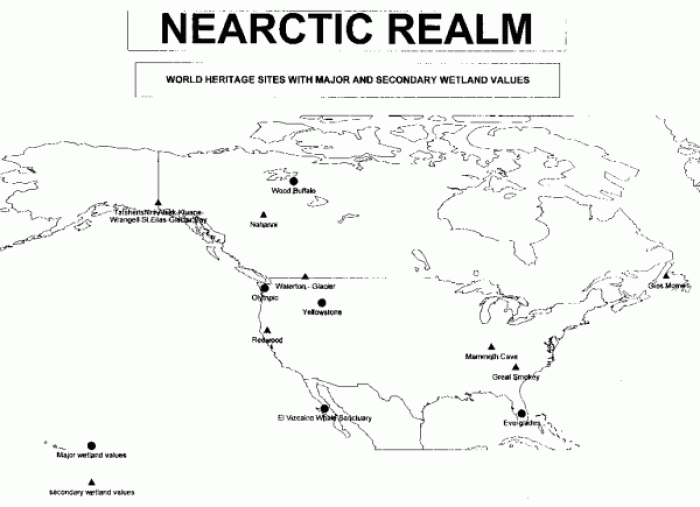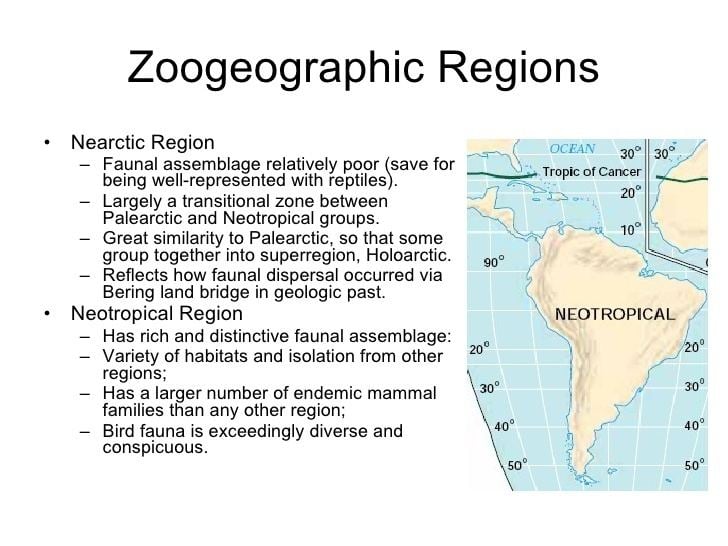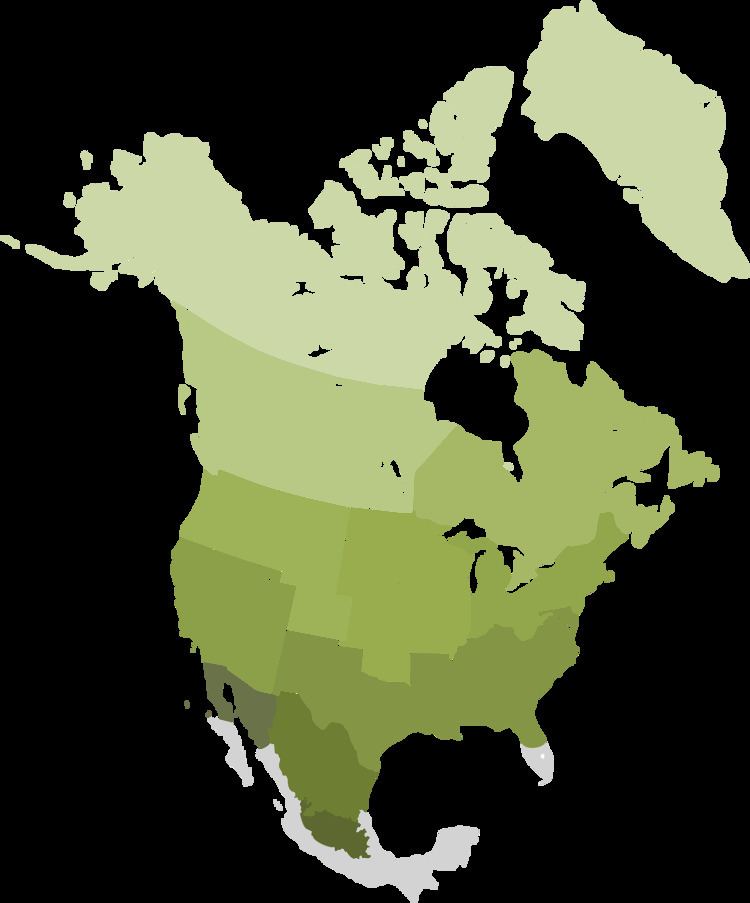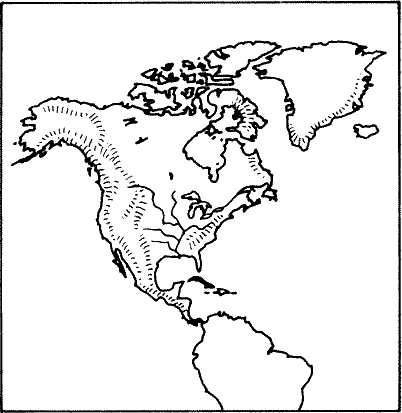 | ||
The Nearctic is one of the eight biogeographic realms constituting the Earth's land surface.
Contents
- Major ecological regions
- Canadian Shield
- Eastern North America
- Western North America
- Northern Mexico and Southwestern North America
- History
- Flora and fauna that originated in the Nearctic
- Flora and fauna endemic to the Nearctic
- References
The Nearctic realm covers most of North America, including Greenland, Central Florida, and the highlands of Mexico. The parts of North America that are not in the Nearctic realm are Eastern Mexico, Southern Florida, Central America, and the Caribbean islands which are part of the Neotropical realm, together with South America.

Major ecological regions

The World Wildlife Fund (WWF) divides the Nearctic into four bioregions, defined as "geographic clusters of ecoregions that may span several habitat types, but have strong biogeographic affinities, particularly at taxonomic levels higher than the species level (genus, family)."
Canadian Shield

The Canadian Shield bioregion extends across the northern portion of the continent, from the Aleutian Islands to Newfoundland. It includes the Nearctic's Arctic Tundra and Boreal forest ecoregions.
In terms of floristic provinces, it is represented by part of the Canadian Province of the Circumboreal Region.
Eastern North America

The Eastern North America bioregion includes the temperate broadleaf and mixed forests of the Eastern United States and southeastern Canada, the Great Plains temperate grasslands of the Central United States and south-central Canada, the temperate coniferous forests of the Southeastern United States and Central Florida. In terms of floristic provinces, it is represented by the North American Atlantic Region and part of the Canadian Province of the Circumboreal Region.
Western North America

The Western North America bioregion includes the temperate coniferous forests of the coastal and mountain regions of southern Alaska, western Canada, and the Western United States from the Pacific Coast and Northern California to the Rocky Mountains, as well as the cold-winter intermountain deserts and xeric shrublands and temperate grasslands and shrublands of the Western United States.
In terms of floristic provinces, it is represented by the Rocky Mountain region.
Northern Mexico and Southwestern North America
The Northern Mexico bioregion includes the mild-winter to cold-winter deserts and xeric shrublands of northern Mexico, Southern California, and the Southwestern United States, including the Chihuahuan, Sonoran, and Mojave Deserts. The Mediterranean climate ecoregions of the Southern and Central Coast of California include the California chaparral and woodlands, California coastal sage and chaparral, California interior chaparral and woodlands, and California montane chaparral and woodlands.
The bioregion also includes the warm temperate and subtropical pine and pine-oak forests, including the Arizona Mountains forests and the Sierra Madre Occidental, Sierra Madre Oriental, and Sierra Juarez and San Pedro Martir pine-oak forests.
In terms of floristic provinces, it is represented by the Madrean Region.
History
Although North America and South America are presently joined by the Isthmus of Panama, these continents were separated for about 180 million years, and evolved very different plant and animal lineages. When the ancient supercontinent of Pangaea split into two about 180 million years ago, North America remained joined to Eurasia as part of the supercontinent of Laurasia, while South America was part of the supercontinent of Gondwana. North America later split from Eurasia. North America has been joined by land bridges to both Asia and South America since then, which allowed an exchange of plant and animal species between the continents, the Great American Interchange.
A former land bridge across the Bering Strait between Asia and North America allowed many plants and animals to move between these continents, and the Nearctic realm shares many plants and animals with the Palearctic. The two realms are sometimes included in a single Holarctic realm.
Many large animals, or megafauna, including horses, camels, mammoths, mastodonts, ground sloths, sabre-tooth cats (Smilodon), the giant short-faced bear (Arctodus simus), and the cheetah, became extinct in North America at the end of the Pleistocene epoch (ice ages), at the same time the first evidence of humans appeared, in what is called the Holocene extinction event. Previously, the megafaunal extinctions were believed to have been caused by the changing climate, but many scientists now believe, while the climate change contributed to these extinctions, the primary cause was hunting by newly arrived humans or, in the case of some large predators, extinction resulting from prey becoming scarce. The American bison (Bison bison), brown bear or grizzly bear (Ursus arctos), moose or Eurasian elk (Alces alces), and elk or wapiti (Cervus canadensis) entered North America around the same time as the first humans, and expanded rapidly, filling ecological niches left empty by the newly extinct North American megafauna.
Flora and fauna that originated in the Nearctic
Animals originally unique to the Nearctic include:
Flora and fauna endemic to the Nearctic
One bird family, the wrentits (Timaliinae), is endemic to the Nearctic region. The Holarctic has four endemic families: divers (Gaviidae), grouse (Tetraoninae), auks (Alcidae), and the waxwings (Bombycillidae). The scarab beetle families Pleocomidae and Diphyllostomatidae (Coleoptera) are also endemic to the Nearctic. The fly species Cynomya cadaverina is also found in high numbers in this area.
Plants families endemic or nearly endemic to the Nearctic include the Crossosomataceae, Simmondsiaceae, and Limnanthaceae.
